Lesson 11.3: Understanding Test Results
- Page ID
- 10385
\( \newcommand{\vecs}[1]{\overset { \scriptstyle \rightharpoonup} {\mathbf{#1}} } \)
\( \newcommand{\vecd}[1]{\overset{-\!-\!\rightharpoonup}{\vphantom{a}\smash {#1}}} \)
\( \newcommand{\id}{\mathrm{id}}\) \( \newcommand{\Span}{\mathrm{span}}\)
( \newcommand{\kernel}{\mathrm{null}\,}\) \( \newcommand{\range}{\mathrm{range}\,}\)
\( \newcommand{\RealPart}{\mathrm{Re}}\) \( \newcommand{\ImaginaryPart}{\mathrm{Im}}\)
\( \newcommand{\Argument}{\mathrm{Arg}}\) \( \newcommand{\norm}[1]{\| #1 \|}\)
\( \newcommand{\inner}[2]{\langle #1, #2 \rangle}\)
\( \newcommand{\Span}{\mathrm{span}}\)
\( \newcommand{\id}{\mathrm{id}}\)
\( \newcommand{\Span}{\mathrm{span}}\)
\( \newcommand{\kernel}{\mathrm{null}\,}\)
\( \newcommand{\range}{\mathrm{range}\,}\)
\( \newcommand{\RealPart}{\mathrm{Re}}\)
\( \newcommand{\ImaginaryPart}{\mathrm{Im}}\)
\( \newcommand{\Argument}{\mathrm{Arg}}\)
\( \newcommand{\norm}[1]{\| #1 \|}\)
\( \newcommand{\inner}[2]{\langle #1, #2 \rangle}\)
\( \newcommand{\Span}{\mathrm{span}}\) \( \newcommand{\AA}{\unicode[.8,0]{x212B}}\)
\( \newcommand{\vectorA}[1]{\vec{#1}} % arrow\)
\( \newcommand{\vectorAt}[1]{\vec{\text{#1}}} % arrow\)
\( \newcommand{\vectorB}[1]{\overset { \scriptstyle \rightharpoonup} {\mathbf{#1}} } \)
\( \newcommand{\vectorC}[1]{\textbf{#1}} \)
\( \newcommand{\vectorD}[1]{\overrightarrow{#1}} \)
\( \newcommand{\vectorDt}[1]{\overrightarrow{\text{#1}}} \)
\( \newcommand{\vectE}[1]{\overset{-\!-\!\rightharpoonup}{\vphantom{a}\smash{\mathbf {#1}}}} \)
\( \newcommand{\vecs}[1]{\overset { \scriptstyle \rightharpoonup} {\mathbf{#1}} } \)
\( \newcommand{\vecd}[1]{\overset{-\!-\!\rightharpoonup}{\vphantom{a}\smash {#1}}} \)
\(\newcommand{\avec}{\mathbf a}\) \(\newcommand{\bvec}{\mathbf b}\) \(\newcommand{\cvec}{\mathbf c}\) \(\newcommand{\dvec}{\mathbf d}\) \(\newcommand{\dtil}{\widetilde{\mathbf d}}\) \(\newcommand{\evec}{\mathbf e}\) \(\newcommand{\fvec}{\mathbf f}\) \(\newcommand{\nvec}{\mathbf n}\) \(\newcommand{\pvec}{\mathbf p}\) \(\newcommand{\qvec}{\mathbf q}\) \(\newcommand{\svec}{\mathbf s}\) \(\newcommand{\tvec}{\mathbf t}\) \(\newcommand{\uvec}{\mathbf u}\) \(\newcommand{\vvec}{\mathbf v}\) \(\newcommand{\wvec}{\mathbf w}\) \(\newcommand{\xvec}{\mathbf x}\) \(\newcommand{\yvec}{\mathbf y}\) \(\newcommand{\zvec}{\mathbf z}\) \(\newcommand{\rvec}{\mathbf r}\) \(\newcommand{\mvec}{\mathbf m}\) \(\newcommand{\zerovec}{\mathbf 0}\) \(\newcommand{\onevec}{\mathbf 1}\) \(\newcommand{\real}{\mathbb R}\) \(\newcommand{\twovec}[2]{\left[\begin{array}{r}#1 \\ #2 \end{array}\right]}\) \(\newcommand{\ctwovec}[2]{\left[\begin{array}{c}#1 \\ #2 \end{array}\right]}\) \(\newcommand{\threevec}[3]{\left[\begin{array}{r}#1 \\ #2 \\ #3 \end{array}\right]}\) \(\newcommand{\cthreevec}[3]{\left[\begin{array}{c}#1 \\ #2 \\ #3 \end{array}\right]}\) \(\newcommand{\fourvec}[4]{\left[\begin{array}{r}#1 \\ #2 \\ #3 \\ #4 \end{array}\right]}\) \(\newcommand{\cfourvec}[4]{\left[\begin{array}{c}#1 \\ #2 \\ #3 \\ #4 \end{array}\right]}\) \(\newcommand{\fivevec}[5]{\left[\begin{array}{r}#1 \\ #2 \\ #3 \\ #4 \\ #5 \\ \end{array}\right]}\) \(\newcommand{\cfivevec}[5]{\left[\begin{array}{c}#1 \\ #2 \\ #3 \\ #4 \\ #5 \\ \end{array}\right]}\) \(\newcommand{\mattwo}[4]{\left[\begin{array}{rr}#1 \amp #2 \\ #3 \amp #4 \\ \end{array}\right]}\) \(\newcommand{\laspan}[1]{\text{Span}\{#1\}}\) \(\newcommand{\bcal}{\cal B}\) \(\newcommand{\ccal}{\cal C}\) \(\newcommand{\scal}{\cal S}\) \(\newcommand{\wcal}{\cal W}\) \(\newcommand{\ecal}{\cal E}\) \(\newcommand{\coords}[2]{\left\{#1\right\}_{#2}}\) \(\newcommand{\gray}[1]{\color{gray}{#1}}\) \(\newcommand{\lgray}[1]{\color{lightgray}{#1}}\) \(\newcommand{\rank}{\operatorname{rank}}\) \(\newcommand{\row}{\text{Row}}\) \(\newcommand{\col}{\text{Col}}\) \(\renewcommand{\row}{\text{Row}}\) \(\newcommand{\nul}{\text{Nul}}\) \(\newcommand{\var}{\text{Var}}\) \(\newcommand{\corr}{\text{corr}}\) \(\newcommand{\len}[1]{\left|#1\right|}\) \(\newcommand{\bbar}{\overline{\bvec}}\) \(\newcommand{\bhat}{\widehat{\bvec}}\) \(\newcommand{\bperp}{\bvec^\perp}\) \(\newcommand{\xhat}{\widehat{\xvec}}\) \(\newcommand{\vhat}{\widehat{\vvec}}\) \(\newcommand{\uhat}{\widehat{\uvec}}\) \(\newcommand{\what}{\widehat{\wvec}}\) \(\newcommand{\Sighat}{\widehat{\Sigma}}\) \(\newcommand{\lt}{<}\) \(\newcommand{\gt}{>}\) \(\newcommand{\amp}{&}\) \(\definecolor{fillinmathshade}{gray}{0.9}\)The basics
Frequency distributions
|
Score on test |
Frequency |
Central tendency measures |
|---|---|---|
|
17 |
1 |
|
|
18 |
1 |
|
|
19 |
0 |
|
|
20 |
3 |
|
|
21 |
2 |
|
|
22 |
6 |
Mode |
|
23 |
3 |
Median |
|
24 |
2 |
Mean |
|
25 |
0 |
|
|
26 |
2 |
|
|
27 |
6 |
Mode |
|
28 |
2 |
|
|
29 |
2 |
|
|
30 |
1 |
|
|
TOTAL |
31 |
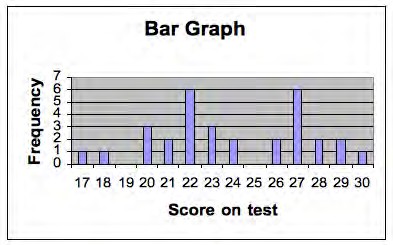 Exhibit \(\PageIndex{1}\): Tests scores from\(\PageIndex{1}\) represented as a bar graph. (CC-BY-NC; K. Siefert, R. Sutton via Educational Psychology)
Exhibit \(\PageIndex{1}\): Tests scores from\(\PageIndex{1}\) represented as a bar graph. (CC-BY-NC; K. Siefert, R. Sutton via Educational Psychology)
Central tendency and variability
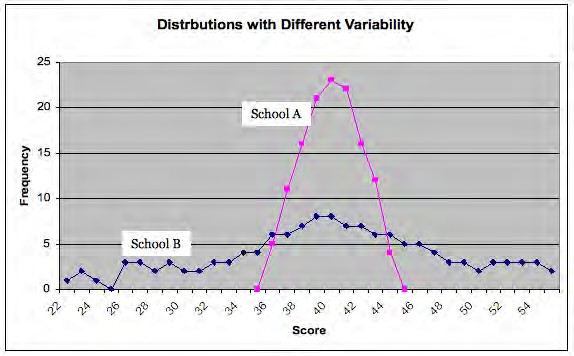 Exhibit \(\PageIndex{2}\): Fourth grade math scores in two different schools with the same mean but different variability. (CC-BY-NC; K. Siefert, R. Sutton via Educational Psychology)
Exhibit \(\PageIndex{2}\): Fourth grade math scores in two different schools with the same mean but different variability. (CC-BY-NC; K. Siefert, R. Sutton via Educational Psychology)
Calculating a standard deviation
|
Score (Step 1, order) |
Deviation from the mean |
Squared deviation from the mean |
|
|---|---|---|---|
|
3 |
-3 |
9 |
|
|
3 |
-3 |
9 |
|
|
4 |
-2 |
4 |
(Step 4-5, complete the calculations) |
|
5 |
-1 |
1 |
Formula: |
|
5 |
-1 |
1 |
\( \dfrac{\sqrt{\sum \left ( Score-Mean \right )^{2}}}{N} \) |
|
6 |
0 |
0 |
N = Number of score |
|
7 |
1 |
1 |
|
|
7 |
1 |
1 |
|
|
7 |
1 |
1 |
|
|
9 |
3 |
9 |
|
|
10 |
4 |
4 |
|
|
TOTAL = 66 |
40 |
||
|
(Step 2, calculate mean) MEAN 66/11= 6.0 |
(Step 3, calculate deviations) Mean= 40 /11= 3.64 |
(Step 6, find the standard deviation) Standard deviation=\( \sqrt{3.64} =1.91 \) |
The normal distribution
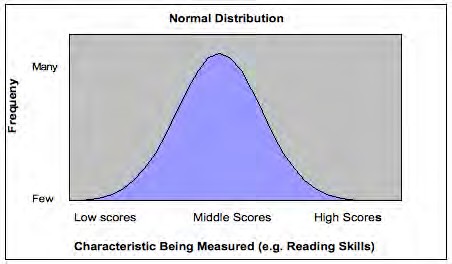
Figure \(\PageIndex{3}\): Bell shaped curve of normal distribution. (CC-BY-NC; K. Siefert, R. Sutton via Educational Psychology)
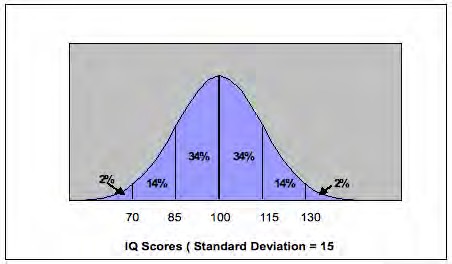 Figure \(\PageIndex{4}\): Normal distribution for an IQ test with mean 100 and standard deviation 15. (CC-BY-NC; K. Siefert, R. Sutton via Educational Psychology)
Figure \(\PageIndex{4}\): Normal distribution for an IQ test with mean 100 and standard deviation 15. (CC-BY-NC; K. Siefert, R. Sutton via Educational Psychology)
Kinds of test scores
Grade equivalent sores
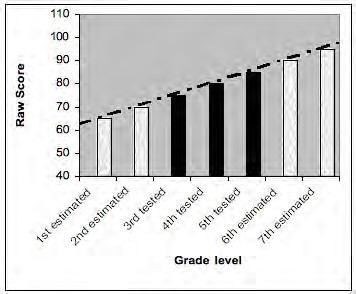 Figure \(\PageIndex{5}\): Using trend lines to estimate grade equivalent scores. (CC-BY-NC; K. Siefert, R. Sutton via Educational Psychology)
Figure \(\PageIndex{5}\): Using trend lines to estimate grade equivalent scores. (CC-BY-NC; K. Siefert, R. Sutton via Educational Psychology)


